Hanbury Hospital Home
(John Capel Hanbury Hospital)
(John Capel Hanbury Hospital)
Manor Road, Woodford Bridge, Essex IG8 8AE
Medical
dates:
Medical
character:
Acute. Later, physical handicap.
The John Capel Hanbury Hospital opened in 1923 in the Boys' Garden City, Woodford Bridge
(see below). It replaced Her Majesty's Hospital in Stepney Causeway, which had been the main hospital for the Dr Barnardo's organisation.
Named after its principal benefactor, John Capel Hanbury (1853-1921), the Hospital had 75 beds. It consisted of a central administration block with wings either side containing the wards.
In 1947 it merged with the Australasian Hospital in Barkingside.
In November 1952 it became the Hanbury Hospital Home, providing care for physically disabled children. The wards were converted into dormitories, at the end of which were lounges (one contained a TV). An annexe was built to the right of the building for use as a schoolroom.
The Hospital Home closed in August 1975, when the New Mossford Centre opened.
Named after its principal benefactor, John Capel Hanbury (1853-1921), the Hospital had 75 beds. It consisted of a central administration block with wings either side containing the wards.
In 1947 it merged with the Australasian Hospital in Barkingside.
In November 1952 it became the Hanbury Hospital Home, providing care for physically disabled children. The wards were converted into dormitories, at the end of which were lounges (one contained a TV). An annexe was built to the right of the building for use as a schoolroom.
The Hospital Home closed in August 1975, when the New Mossford Centre opened.
Present status (April 2009)
The land of the Garden City was sold for housing development in 1978 and the Hospital was demolished, along with most of the cottages.
Gwynne House, the original Georgian mansion, and its stables were sold in 1985. The house and the chapel are now the Prince Regent Hotel.

The entrance drive to the Prince Regent Hotel.
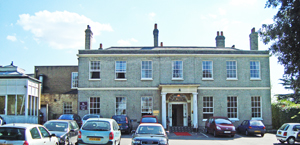
Gwynne House is now Grade II listed.
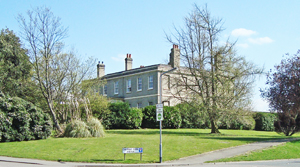
The building from the west.
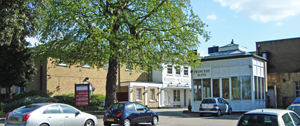
The original mansion house has been extended to provide banqueting suites (above and below).
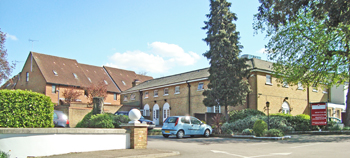
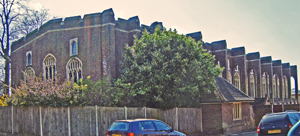
The flying buttresses of the chapel make it a most unusual sight. It is linked to the hotel by a low-rise building.
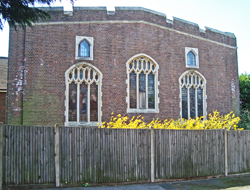
The eastern elevation of the former chapel with Perpendicular-style window tracery.

The chapel, as seen from Kinnaird Way.
Boys' Garden City
In 1909 the Council of Dr Barnardo's Homes, under the direction of William Baker, purchased Gwynne House, a Georgian mansion built in 1816, together with 39 acres of land, in order to establish a home for destitute boys.
The first 34 children arrived at the estate from Labour House and Sheppard House (Dr Barnardo's Homes in the East End of London). They began the initial preparation for the building work, digging trenches and making paths and roadways. They lived in Gwynne House and other buildings on the site.
On 21st July 1910 the foundation stones for the first three houses were officially laid by the Prince and Princess Alexander of Teck in memory of King Edward VII, and by Mrs Fleming in memory of Canon James Fleming, Chaplain in Ordinary to King Edward VII.
By December 1911 five cottages had been built. The first to be completed was named King's, after Edward VII who had died on 6th May 1910. By May 1912 twelve cottages had been completed and some 300 children were resident. A dining hall - Canada Hall - had also been added, funded by contributions from Canada. The Hall also served a meeting room. A donation of £1,000 from Mr Andrew Johnson, J.P., D.L., a local man, enabled a swimming pool to be built.
The Garden City was officially opened on 23rd May 1912 by the Duchess of Albany. Each cottage housed 30 boys in dormitories of 15 beds each. A house mother or matron supervised the children, who were responsible for various domestic chores.
The boys attended local schools and were also taught trades, such as tailoring, boot-making and baking. In addition, they worked in the grounds and vegetable gardens. Physical training and sports were encouraged. In bad weather Canada Hall was used as a gymnasium (this involved moving 200 tables and 400 benches).
In 1918 some 10 acres of the Roding House estate were purchased so that the Garden City could be extended.
The John Capel Hanbury Hospital opened in 1923. Until then, two cottages on the site, Pellew House and New Zealand House, had been used as a hospital and sanatorium.
In 1929 building work began on a chapel. Name the Chapel of the Good Shepherd, it could seat 500. It was dedicated in 1932 by the Bishop of Chelmsford.
By the beginning of the 1930s, of the 30 cottages in the original plan, 20 had been completed and were occupied.
The Garden City eventually also contained a school, a gymnasium (added in 1936) and a steam bakery (which also provided baked goods for the Girls' Village Home in Barkingside).
At the outbreak of WW2 in 1939 the Garden City contained 750 boys, who were all evacuated.
When the children returned after the war, girls began to be admitted for the first time.
However, as government policy moved towards smaller 'family' groups, Dr Barnardo's began to close its children's homes.
The Garden City closed in 1977.
In 1909 the Council of Dr Barnardo's Homes, under the direction of William Baker, purchased Gwynne House, a Georgian mansion built in 1816, together with 39 acres of land, in order to establish a home for destitute boys.
The first 34 children arrived at the estate from Labour House and Sheppard House (Dr Barnardo's Homes in the East End of London). They began the initial preparation for the building work, digging trenches and making paths and roadways. They lived in Gwynne House and other buildings on the site.
On 21st July 1910 the foundation stones for the first three houses were officially laid by the Prince and Princess Alexander of Teck in memory of King Edward VII, and by Mrs Fleming in memory of Canon James Fleming, Chaplain in Ordinary to King Edward VII.
By December 1911 five cottages had been built. The first to be completed was named King's, after Edward VII who had died on 6th May 1910. By May 1912 twelve cottages had been completed and some 300 children were resident. A dining hall - Canada Hall - had also been added, funded by contributions from Canada. The Hall also served a meeting room. A donation of £1,000 from Mr Andrew Johnson, J.P., D.L., a local man, enabled a swimming pool to be built.
The Garden City was officially opened on 23rd May 1912 by the Duchess of Albany. Each cottage housed 30 boys in dormitories of 15 beds each. A house mother or matron supervised the children, who were responsible for various domestic chores.
The boys attended local schools and were also taught trades, such as tailoring, boot-making and baking. In addition, they worked in the grounds and vegetable gardens. Physical training and sports were encouraged. In bad weather Canada Hall was used as a gymnasium (this involved moving 200 tables and 400 benches).
In 1918 some 10 acres of the Roding House estate were purchased so that the Garden City could be extended.
The John Capel Hanbury Hospital opened in 1923. Until then, two cottages on the site, Pellew House and New Zealand House, had been used as a hospital and sanatorium.
In 1929 building work began on a chapel. Name the Chapel of the Good Shepherd, it could seat 500. It was dedicated in 1932 by the Bishop of Chelmsford.
By the beginning of the 1930s, of the 30 cottages in the original plan, 20 had been completed and were occupied.
The Garden City eventually also contained a school, a gymnasium (added in 1936) and a steam bakery (which also provided baked goods for the Girls' Village Home in Barkingside).
At the outbreak of WW2 in 1939 the Garden City contained 750 boys, who were all evacuated.
When the children returned after the war, girls began to be admitted for the first time.
However, as government policy moved towards smaller 'family' groups, Dr Barnardo's began to close its children's homes.
The Garden City closed in 1977.
http://m.ealingtimes.co.uk
www.barnardos.org.uk
www.britishhomechildgroupinternational.com
www.childrenshomes.org.uk (1)
www.childrenshomes.org.uk (2)
www.goldonian.org
www.happywarrior.org
Return to home page